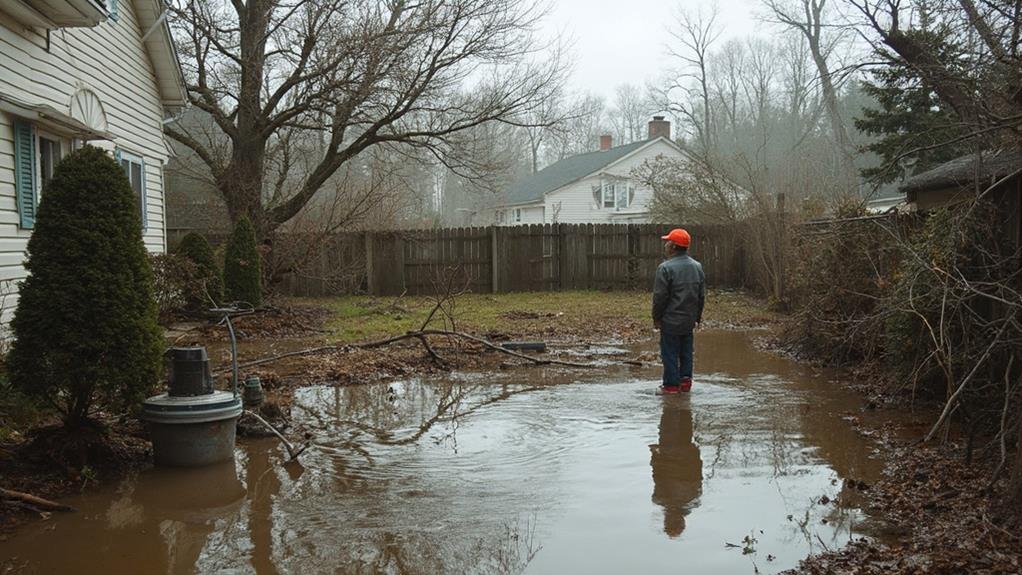A homeowner's checklist for addressing storm-related standing water begins with assessing the extent of flooding and ensuring safety by turning off electrical power. Next, remove debris and clear drainage paths to improve water flow. Implement temporary solutions like sandbags or pumps to divert water. Repair existing drainage systems, including gutters and downspouts. Improve landscape grading to direct water away from structures. Consider installing permanent water management features such as French drains or rain gardens. Regular maintenance is crucial to prevent future issues. By following these steps, homeowners can effectively manage standing water and protect their property from storm-related damage. Further exploration of these strategies can lead to even more comprehensive solutions.
Assess the Extent of Flooding
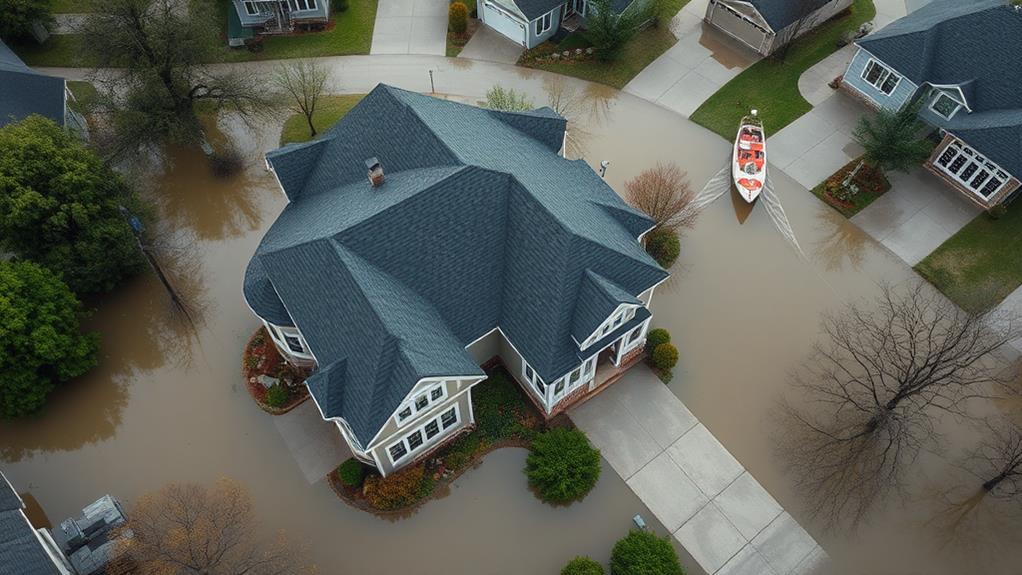
After a storm subsides, the first critical step for homeowners is to assess the extent of flooding on their property. This evaluation helps determine the appropriate course of action and potential risks.
Begin by safely surveying the affected areas, noting the depth and spread of standing water. Pay particular attention to basements, crawl spaces, and low-lying areas around the house.
Measure the water depth in various locations and document any visible damage to structures, utilities, or personal belongings. Identify potential hazards such as downed power lines, gas leaks, or compromised foundations. Take photographs or videos for insurance purposes and future reference.
Assess the water's source and determine if it's still actively entering the property. Check for ongoing leaks, overflowing gutters, or water seeping through walls. Evaluate nearby storm drains and drainage systems for blockages that may be impeding water flow. Consider the topography of your property and how it affects water accumulation and runoff.
This comprehensive assessment will guide your next steps in addressing the flooding, whether it involves DIY solutions or professional intervention, and help prioritize immediate actions to mitigate further damage and ensure safety.
Ensure Safety First
Before taking any action to address standing water, ensuring the safety of all occupants is paramount. Turn off all electrical power to affected areas to prevent electrocution risks. If the main breaker is submerged, contact a licensed electrician immediately. Avoid entering flooded areas until the power is confirmed off.
Wear appropriate personal protective equipment, including waterproof boots, gloves, and eye protection. Standing water may contain harmful contaminants, including sewage, chemicals, or debris. If possible, use a long stick or pole to check for hidden hazards beneath the water's surface before stepping in.
Be aware of potential structural damage caused by flooding. Look for signs of foundation cracks, warped floors, or compromised walls. If you suspect structural issues, evacuate the premises and seek professional assessment before re-entry.
Watch for wildlife that may have been displaced by flooding, such as snakes or rodents. Use caution when moving debris or entering previously flooded areas. If gas appliances were affected, do not attempt to operate them until a qualified technician has inspected and cleared them for use.
Remove Debris and Obstructions
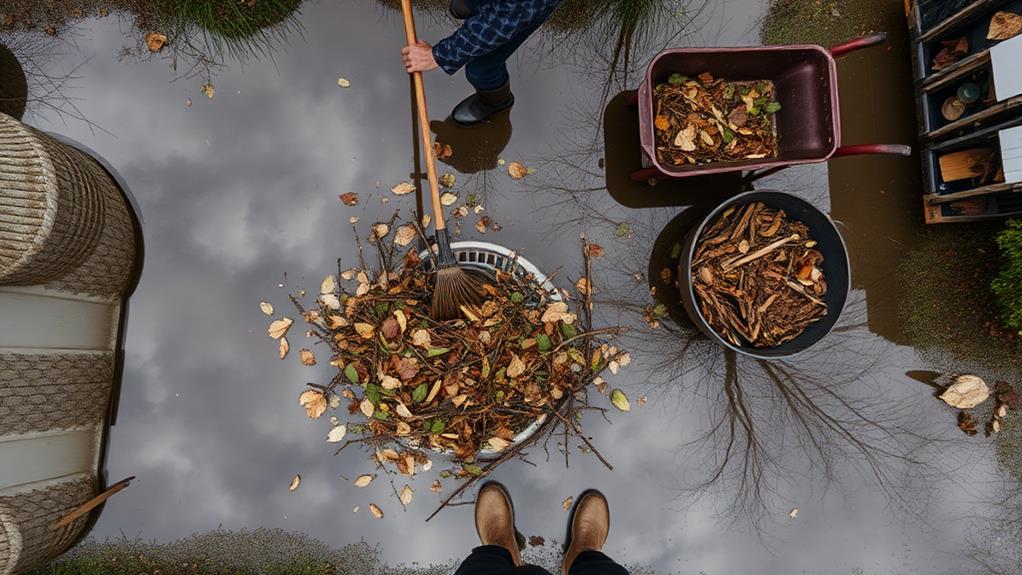
Once safety measures are in place, the next step in addressing storm-related standing water is to remove debris and obstructions. This process is crucial for facilitating proper drainage and preventing further water accumulation. Begin by surveying the affected area, identifying and removing large objects such as fallen branches, displaced furniture, or other items that may impede water flow.
Use appropriate tools like rakes, shovels, or debris grabbers to clear smaller debris, including leaves, twigs, and sediment from drainage paths, gutters, and downspouts. Pay special attention to storm drains and culverts, as these are critical for directing water away from your property. If these areas are clogged, carefully remove blockages to restore proper function.
For standing water in yard areas, check for any depressions or low spots where water tends to collect. Fill these areas with soil or create channels to guide water towards proper drainage routes. In cases of severe flooding or large debris accumulation, consider enlisting professional help or heavy equipment for more efficient removal. Remember to document the cleanup process with photos for insurance purposes, if applicable. By thoroughly removing debris and obstructions, you'll significantly improve water drainage and reduce the risk of property damage.
Implement Temporary Drainage Solutions
Expediency is key when implementing temporary drainage solutions to address storm-related standing water. Homeowners should focus on quick, effective methods to redirect water away from vulnerable areas. One practical solution is to create temporary channels or trenches to guide water towards storm drains or lower-lying areas. These can be dug using shovels or garden tools, ensuring a slight downward slope for proper water flow.
Sandbags are another versatile option for managing standing water. Strategically placed, they can form barriers to divert water or create makeshift dams. For smaller areas, consider using inflatable flood barriers, which are easy to deploy and store. Submersible pumps can be utilized to remove water from basements or crawl spaces, directing it to safer locations away from the property.
In cases where water threatens to enter the home, installing plastic sheeting along walls and doorways can provide temporary protection. Coupling this with portable sump pumps can help remove any water that does manage to seep through. Remember, these solutions are temporary measures designed to mitigate immediate risks while more permanent drainage improvements are planned and implemented.
Repair Existing Drainage Systems
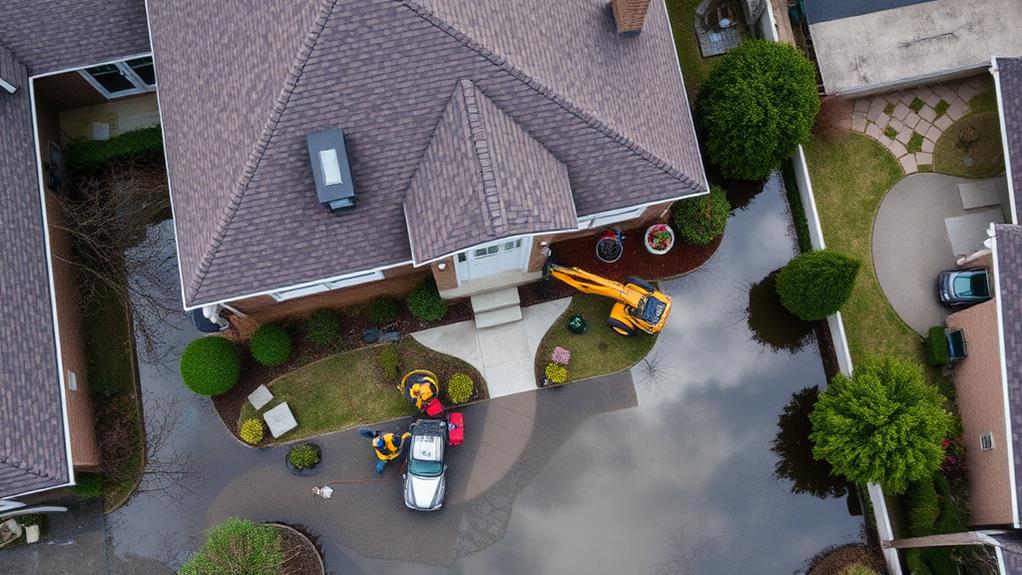
After implementing temporary measures, homeowners must turn their attention to repairing existing drainage systems. Begin by inspecting gutters and downspouts for clogs, damage, or misalignment. Clear debris, replace damaged sections, and ensure proper slope for efficient water flow.
Check underground drainage pipes for blockages or cracks using a camera inspection if necessary. Repair or replace damaged pipes to restore proper functionality.
Assess the condition of French drains, catch basins, and other drainage structures on the property. Remove sediment buildup, replace deteriorated components, and regrade surrounding areas to maintain proper water flow. Evaluate the effectiveness of surface grading around the house, correcting any slopes that direct water towards the foundation.
For homes with sump pumps, test the system thoroughly and replace faulty components. Consider installing a battery backup or water-powered pump for added protection during power outages. If applicable, clean and maintain septic systems to prevent overflow during heavy rainfall.
Improve Landscape Grading
Proper landscape grading is crucial for effective stormwater management and prevention of standing water issues. To improve landscape grading, start by identifying low spots in your yard where water tends to accumulate. These areas should be filled and leveled to create a gentle slope away from your home's foundation.
Ensure that the ground slopes at least 6 inches over a distance of 10 feet from your house. This gradient will direct water away from the structure, reducing the risk of basement flooding and foundation damage. Pay special attention to areas around downspouts, as these are common problem spots for water accumulation.
Consider creating swales or shallow ditches to guide water away from problem areas and toward appropriate drainage points. These can be subtle landscape features that blend with your yard's aesthetics while serving a practical purpose. For larger properties, you may need to implement more extensive grading solutions, such as terracing or installing French drains.
When improving landscape grading, be mindful of your neighbors' properties and local regulations. Ensure that your grading efforts do not redirect water onto adjacent lots or violate any municipal codes.
Install Permanent Water Management Features
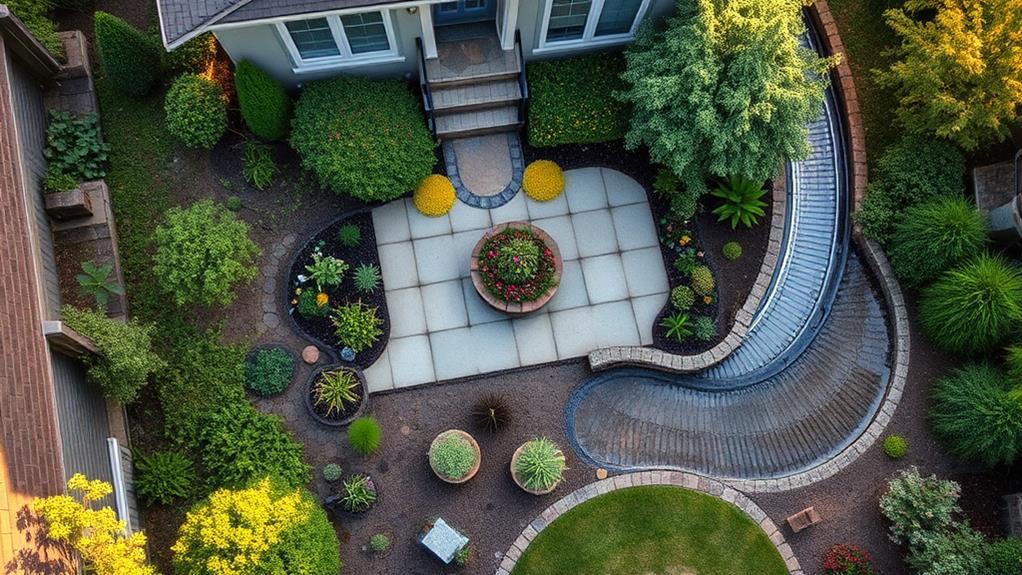
While improving landscape grading can significantly reduce standing water issues, installing permanent water management features offers a long-term solution for effective stormwater control. These features are designed to capture, redirect, or absorb excess water, preventing it from accumulating in problematic areas.
One popular option is a French drain, which consists of a perforated pipe surrounded by gravel. This system collects and diverts water away from vulnerable areas. Rain gardens are another effective feature, utilizing native plants with deep root systems to absorb and filter stormwater.
For properties with persistent flooding, dry wells or underground cisterns can be installed to collect and slowly release water into the surrounding soil. Permeable pavement systems, such as porous asphalt or interlocking pavers, allow water to infiltrate the ground rather than run off. Swales and bioswales are shallow, vegetated channels that slow water flow and promote infiltration.
For larger properties, retention or detention ponds can be constructed to collect and gradually release stormwater. When installing these features, consider factors such as soil type, property slope, and local regulations. Professional consultation may be necessary to ensure proper design and implementation for optimal water management results.
Monitor and Maintain Regularly
Regular monitoring and maintenance are crucial components of any effective stormwater management system. Homeowners should establish a routine inspection schedule to ensure all water management features are functioning properly. This includes checking gutters, downspouts, French drains, and other drainage systems for clogs or damage. Clear debris from these areas regularly, especially after storms or during fall when leaves accumulate.
Inspect grading around the house to ensure the ground slopes away from the foundation. Address any areas where soil has eroded or settled, as these can lead to water pooling. Check sump pumps periodically, testing them by pouring water into the sump pit and verifying proper operation. Replace batteries in backup systems as needed.
Examine landscaping elements like rain gardens, bioswales, and retention ponds for signs of erosion, excessive sedimentation, or invasive plant growth. Remove sediment and debris that may impede water flow. Prune vegetation around these features to maintain their effectiveness. During dry periods, water plants in rain gardens to keep them healthy and capable of managing runoff during storms.
Keep detailed records of all inspections and maintenance activities performed. This documentation can help identify recurring issues and guide future improvements to your stormwater management system.
Frequently Asked Questions
How Long Can Standing Water Remain Before Causing Structural Damage?
Standing water can cause structural damage within 24 to 48 hours. The severity depends on factors like water depth, building materials, and temperature. Prompt action is crucial to minimize potential harm to foundations, walls, and flooring.
Can I Use My Sump Pump if Electrical Systems Are Affected?
Dry land, submerged circuits: a risky contrast. Using a sump pump with affected electrical systems is dangerous. Opt for battery-powered or gas-powered pumps instead. Always prioritize safety and consult a professional before attempting any water removal.
What Types of Insurance Typically Cover Storm-Related Water Damage?
Homeowners insurance typically covers storm-related water damage from wind-driven rain or roof leaks. Flood insurance is necessary for damage caused by rising water. Some policies may include coverage for sewer backup or sump pump failure.
Are There Eco-Friendly Solutions for Managing Standing Water on My Property?
Several eco-friendly solutions exist for managing standing water on your property. These include creating rain gardens, installing permeable pavement, implementing bioswales, using native plants for water absorption, and constructing green roofs to reduce runoff and promote natural drainage.
How Do I Prevent Mold Growth After Addressing Standing Water Issues?
To prevent mold growth after addressing standing water, thoroughly dry affected areas within 24-48 hours. Use dehumidifiers, fans, and proper ventilation. Clean and disinfect surfaces with appropriate solutions. Monitor humidity levels and address any remaining moisture sources promptly.
Conclusion
In conclusion, addressing storm-related standing water requires a systematic approach. From initial assessment to long-term solutions, homeowners must remain vigilant in their efforts to manage excess water. As the saying goes, "An ounce of prevention is worth a pound of cure." By implementing proper drainage systems, improving landscape grading, and maintaining water management features, property owners can significantly reduce the risk of flooding and water damage. Regular monitoring and maintenance are crucial for long-term success in water management.
